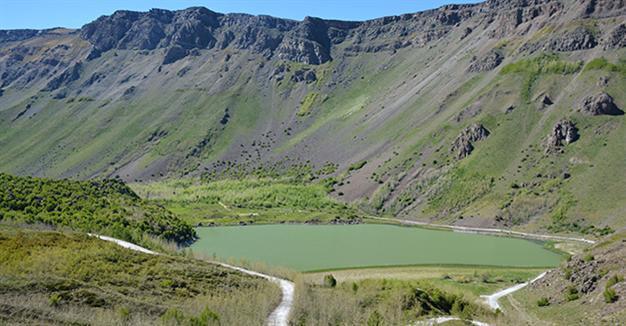Nemrut crater lake to become international geopark
BİTLİS – Anadolu Agency

AA photo
Work has started studies on the world’s second largest crater lake as part of the International Geopark Project under the auspices of Bitlis Eren University (BEU).
“The tourism potential of Eastern Anatolia will increase after Nemrut acquires international geopark status. It will be Turkey’s second international geopark,” said BEÜ Deputy Rector Professor Aydın Büyüksaraç, who is overseeing the research.
Academics will conduct research on the geological formation, endemic plants, animal species, archaeological sites on Lake Nemrut, which has received the Award of Excellence from the European Destinations of Excellence (EDEN).
A seven-person team, including academics from geophysics, geology, biology, archaeology departments and tourism experts, recently began studies on the area.
The project, which is being realized with support from the Eastern Anatolian Development Agency (EADA), is set to provide an important contribution to the city’s tourism and economy.
The crater lake, which covers a large area, boasts a unique geography, Büyüksaraç said, adding that Nemrut and its surroundings were among the biggest volcanic mountains in this region.
“We started the work titled ‘International Geopark formation’ in Nemrut with the support of EADA. First, we will research the geological formation, endemic plants, animal species, lakes and archaeological settlements in the area. The Mount Nemrut volcano was last active in 1941,” he said, noting that the only other volcano in Turkey was Erciyes in the Central Anatolian province of Kayseri, although that has been dormant for the past 600 years.
Büyüksaraç said investments to be made in the area would aid the region’s tourism activity and that the area had an important tourism potential.
“Five different lakes were formed as a result of an explosion in this area. The largest lake’s depth is almost 155 meters. The average depth of the lake is 100 meters. It is a fairly deep lake,” he said. “The width of the mouth of the crater is almost 48 square kilometers and the bottom width is 36 square kilometers. Therefore, its structure is like a cone,” he said.
Second international geopark in Turkey
Büyüksaraç said they would send studies and reports carried out in the area to UNESCO, adding that UNESCO would conduct the necessary studies to bestow international geopark status on the area.
“After it attains international status, the interest of foreign tourists will increase in this place because of its natural formations. Besides, this place will draw the attention of visitors with its outdoor sports. There are many winter sports to engage in on Mount Nemrut. A beautiful facility and lift system are available here. Paragliding can also be done here because there is plenty of wind. Walking trails and natural areas can be visited with guides. Nemrut has a lot of touristic potential. Van Lake can also be seen here.”
He said reports would first be prepared, as well as feasibility studies.
“We will advise the governor’s office, special administration, municipality and other local authorities on sporting activities, excursions and picnic and recreation areas that they will facilitate or provide in this area. There is a need to lay the foundations of different things that can attract the attention of visitors. From now on, the focus will be on investments. Because of security issues, this place has been of secondary importance. But we are entering a period in which Eastern Anatolia and the region will be associated with tourism. By creating infrastructure for such areas, we will draw tourists’ attention,” Büyüksaraç said.
Special permission needed
Büyüksaraç said they would conduct a three-month feasibility study in the caldera before sending the report to UNESCO. A team from the U.N. agency is subsequently expected to visit the area.
Stating that the other studies would take a few years, the professor said, “Special permission is needed for the establishment of new infrastructure in this area.”
Büyüksaraç also said better infrastructure would help visitors better access hot springs in the region.
